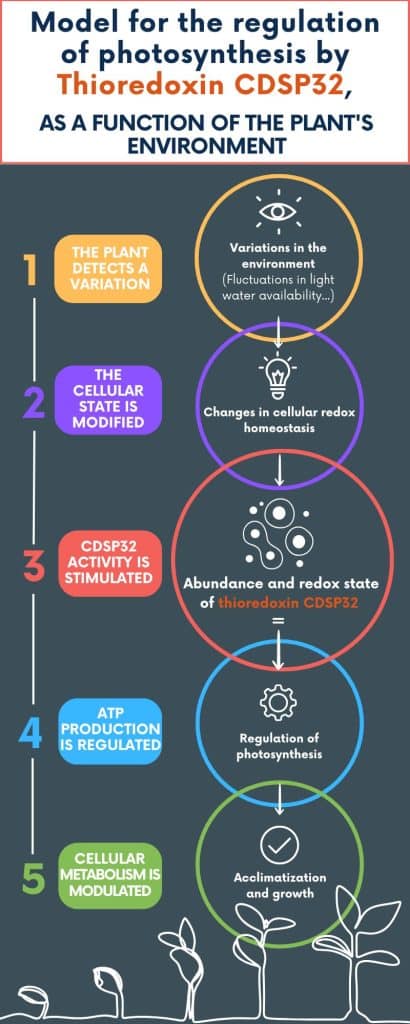BIAM researchers have highlighted the role of an enzyme, the thioredoxin CDSP32, in adjusting the photosynthetic metabolism of plants, in response to fluctuations in their environment. This advance could contribute to the development of crops better adapted to climatic challenges.
Photosynthesis, metabolism essential for plant growth and life on Earth, converts light into molecules such as glucose, necessary for the production of energy and the development of chlorophyllous organisms. This process is regulated by complex mechanisms that allow plant adaptation to variable conditions, such as night-day transitions or water deficit. Thioredoxins, present in chloroplasts, are enzymes controlling the activity of proteins by modulating the redox state of one of their amino acids, cysteine. They play key roles in the regulation of the two phases of photosynthesis: the conversion of light energy into chemical energy and the use of this energy to synthesize sugars.
A new role revealed for the thioredoxin CDSP32
Discovered 25 years ago by BIAM researchers, the thioredoxin CDSP32 protects cellular structures against oxidative stress during climatic constraints such as drought. It had never been directly linked to the regulation of photosynthesis. Using various techniques, ranging from genetics to biophysics, the multidisciplinary teams at BIAM have shown in this study that the thioredoxin CDSP32 very probably controls the activity of ATP synthase. This enzyme plays a central role in converting light energy into ATP, which serves as a source of chemical energy for the cell. Thus, by regulating ATP synthase, CDSP32 allows plants to modulate their energy balance as a function of environmental conditions.
An acclimation strategy to face constraints
The results suggest that the thioredoxin CDSP32 could provide plants with an adaptive advantage during environmental constraints. By adjusting ATP synthase activity, plants optimize their energy metabolism to better withstand stressful conditions. This fine regulation of photosynthetic activity constitutes an essential asset for plant growth in variable environments
Promising prospects
“The research has been carried out on lines of potato, a plant species belonging to the Solanaceae family, modified in the expression of the thioredoxin CDSP32,” explains Pascal Rey, co-author of the discovery. The knowledge acquired could be used for other Solanaceae crops of agronomic interest such as tomato,” he projects. Indeed, targeting these acclimation mechanisms could increase the resilience of crops to environmental constraints and help yield maintenance in the context of climate change.
Autors : Rey P, Henri P, Alric J, Blanchard L, Viola S.
Plant Cell and Environment “Participation of the stress-responsive CDSP32 thioredoxin in the modulation of chloroplast ATP-synthase activity in Solanum tuberosum”. 2024 Aug 27. doi: 10.1111/pce.15101
